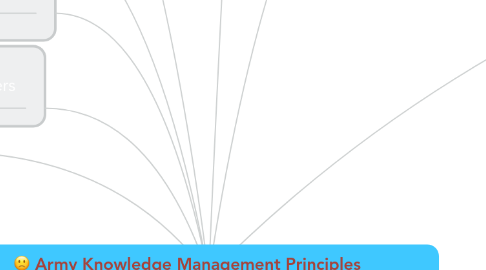
1. embed and use digital media to add to or leverage the existing knowledge assets of the Army.
1.1. training routines
1.2. operations
2. Modify and evolve business rules to meet the commander’s intent and quickly adapt business processes to meet or anticipate emerging threats or business opportunities (situational awareness)
3. Leaders need to incorporate the Core Principles of Collaboration into
3.1. business procedures
3.2. human resources practices
4. PRINCIPLE: Protect and secure assets
4.1. Information
4.2. knowledge
5. RATIONALE:
5.1. Leverage digital media
5.1.1. add
5.1.1.1. context
5.1.1.2. understanding
5.1.1.3. situational awareness
5.1.2. to
5.1.2.1. operations
5.1.2.2. business activities
6. Managers
7. instructional delivery
8. Process
8.1. 6.
8.1.1. RATIONALE:
8.1.1.1. Denying adversaries access to key information gives US and coalition forces the decisive advantage to securely communicate and collaborate across geographic and organizational boundaries
8.1.2. IMPLICATIONS
8.1.2.1. Balance risks regarding “need to know” against “need to protect”
8.1.2.2. Requires leaders of knowledge communities to comply with relevant information assurance regulations and policies
8.2. 7.
8.2.1. PRINCIPLE: Knowledge assests
8.2.1.1. Embed
8.2.1.1.1. in standard business processes
8.2.1.2. Provide access
8.2.1.2.1. to those who need to know
8.2.2. IMPLICATIONS
8.2.2.1. Incumbent on leaders to creatively
8.2.2.2. Convert
8.2.2.2.1. From...
8.2.2.2.2. ...to...
8.2.2.3. Verify content for legality and desired outcome.
8.3. 8.
8.3.1. PRINCIPLE: Use legal and standard business rules and processes across the enterprise
8.3.2. RATIONALE:
8.3.2.1. Established business rules and processes are repeatable
8.3.2.1.1. reducing learning curves
8.3.2.1.2. promoting consistent quality
8.3.3. Lean Six Sigma and continuous process improvement principles apply
8.3.4. IMPLICATIONS
8.3.4.1. Follow standard
8.3.4.1.1. business rules and processes
8.3.4.1.2. set by
9. Users own the collaborative community
9.1. IT providers
10. PRINCIPLE: Use standardized collaboration tool sets
11. Assess what is valuable from past activity
12. Provide access to structural capital to
12.1. accelerate learning curves
12.2. adopt/modify best known practices
13. IMPLICATIONS
13.1. KM applications need to be designed and operate with an enterprise focus, permitting access and searching across systems and organizations without technical or structural impediments
14. In the design and operation of KM systems, leaders need to ensure that there are no organizational or technical barriers blocking access to digital media residing in knowledge bases
15. Train and deploy with them
16. Technology
16.1. Training on and using common collaborative software tool sets
16.1.1. reduces
16.1.1.1. Costs
16.1.1.1.1. Training
16.1.1.1.2. Maintenance
16.1.1.2. impediments
16.1.1.2.1. searching for relevant knowledge across the enterprise
16.1.2. creating
16.1.2.1. Common platform
16.1.2.1.1. exchange
16.1.2.1.2. in / with
16.2. 9.
16.2.1. RATIONALE:
16.2.2. IMPLICATIONS
16.2.2.1. Use approved collaborative tools sets
16.2.2.1.1. Army
16.2.2.1.2. DoD
16.3. 10.
16.3.1. RATIONALE:
16.4. 11.
16.4.1. PRINCIPLE: Use a robust search capability to
16.4.1.1. access contextual knowledge
16.4.1.2. store content for discovery
16.4.2. RATIONALE:
16.4.2.1. Create seamless and ubiquitous service-on-demand when one client application requests one or more services for another application which provides complimentary services
16.4.2.2. PRINCIPLE: Use open architectures to permit searching and access across boundaries
16.4.2.3. With the exception of classified information, knowledge bases should be accessible and searchable by search engines that deliver contextual knowledge and information
16.4.3. IMPLICATIONS
16.4.3.1. Use appropriate content management principles
16.5. 12.
16.5.1. PRINCIPLE: Use portals that permit single sign-on and authentication across the global enterprise, including partners.
16.5.2. RATIONALE:
16.5.2.1. Using the Army’s enterprise portal for access and authentication lessens confusion for users and provides a standard process for accessing enterprise knowledge assets while reducing total cost of ownership of other portals, websites or knowledge networks
16.5.3. IMPLICATIONS
16.5.3.1. portal of first choice
16.5.3.1.1. AKO
16.5.3.1.2. DKO
16.5.3.1.3. Successors
17. People / Culture
17.1. 1.
17.1.1. PRINCIPLE: Train / Educate workforce in KM
17.1.1.1. Leaders
17.1.1.2. Champions
17.1.2. RATIONALE:
17.1.2.1. To create a culture of collaboration, the Army needs to
17.1.2.1.1. educate the next generation KM change agents who
17.1.3. IMPLICATIONS
17.1.3.1. Identify methods for
17.1.3.1.1. curriculum development
17.1.3.2. Train and educate the force
17.1.3.2.1. KM Competency
17.1.3.2.2. at all levels of the Army
17.2. 2.
17.2.1. PRINCIPLE: Reward
17.2.1.1. Knowledge sharing
17.2.1.2. Knowledge management career
17.2.2. RATIONALE:
17.2.2.1. What gets rewarded in organizations gets done
17.2.2.2. Reward structures guide organizational and individual behaviors
17.2.3. IMPLICATIONS
17.2.3.1. Establish KM career fields (where appropriate)
17.2.3.2. Insert performance elements to evaluate knowledge sharing contributions
17.2.3.2.1. NSPS
17.2.3.2.2. OER
17.2.3.2.3. NCOER
17.3. 3.
17.3.1. PRINCIPLE: Establish Doctrine of Collaboration
17.3.2. RATIONALE:
17.3.2.1. A collaborative environment fosters
17.3.2.1.1. new ideas
17.3.2.1.2. understanding
17.3.2.1.3. ways to execute the COMMANDER'S INTENT
17.3.3. IMPLICATIONS
17.3.3.1.
17.3.3.1.1. 1. Responsibility to Provide -
17.3.3.1.2. 2. Empowered to Participate -
17.3.3.1.3. 3. User-driven -
17.4. Collaborative communities are
17.4.1. self-defining
17.4.2. self creating
17.4.3. adaptable
17.5. 4.
17.5.1. PRINCIPLE: Use every
17.5.1.1. Interaction
17.5.1.1.1. face to face
17.5.1.1.2. virtual
17.5.1.2. as an opportunity to
17.5.1.2.1. acquire knowledge
17.5.1.2.2. share knowledge
17.5.2. RATIONALE:
17.5.2.1. Continuous learning is an expected day-to-day activity
17.5.2.2. Learning faster than
17.5.2.2.1. adversaries
17.5.2.2.2. competitors
17.5.2.3. yields results
17.5.2.3.1. short-term
17.5.2.3.2. long-term
17.5.3. IMPLICATIONS
17.5.3.1. Leaders need to frame day-to-day activities as
17.5.3.1.1. learning opportunities to accelerate
17.5.3.2. Promote learning in
17.5.3.2.1. teams
17.5.3.2.2. social networks
17.6. 5.
17.6.1. PRINCIPLE: Prevent knowledge loss
17.6.2. RATIONALE:
17.6.2.1. Knowledge
17.6.2.1.1. is perishable
17.6.2.1.2. has a life cycle
17.6.3. IMPLICATIONS
17.6.3.1. Document it
17.6.3.2. Share with those who need to know
